Bruno Conche
Distributed Ensembles of Reinforcement Learning Agents for Electricity Control
Aug 30, 2022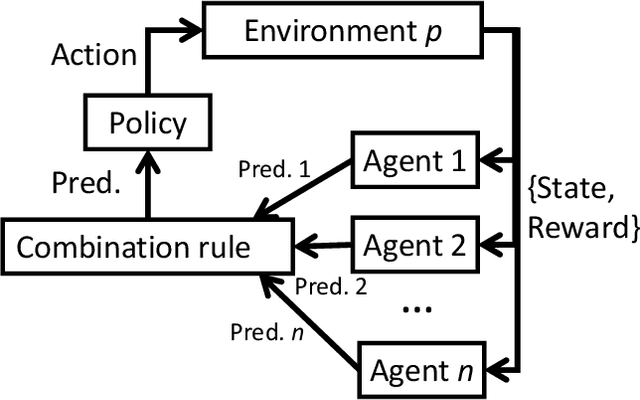
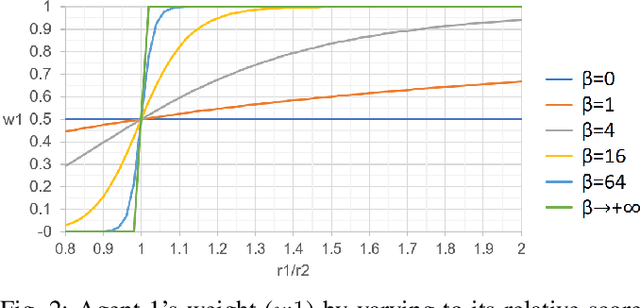

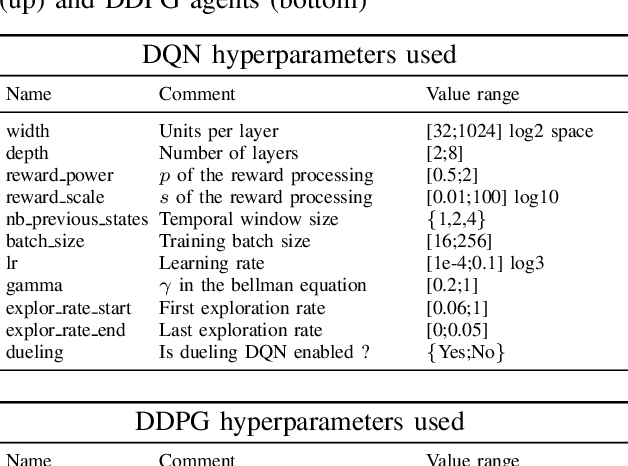
Abstract:Deep Reinforcement Learning (or just "RL") is gaining popularity for industrial and research applications. However, it still suffers from some key limits slowing down its widespread adoption. Its performance is sensitive to initial conditions and non-determinism. To unlock those challenges, we propose a procedure for building ensembles of RL agents to efficiently build better local decisions toward long-term cumulated rewards. For the first time, hundreds of experiments have been done to compare different ensemble constructions procedures in 2 electricity control environments. We discovered an ensemble of 4 agents improves accumulated rewards by 46%, improves reproducibility by a factor of 3.6, and can naturally and efficiently train and predict in parallel on GPUs and CPUs.
Weakly Supervised Faster-RCNN+FPN to classify animals in camera trap images
Aug 30, 2022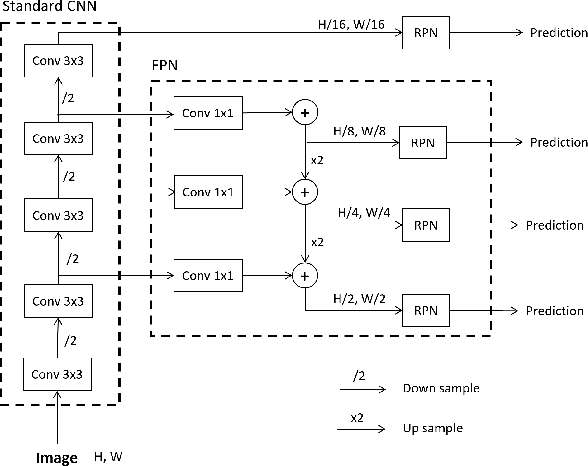
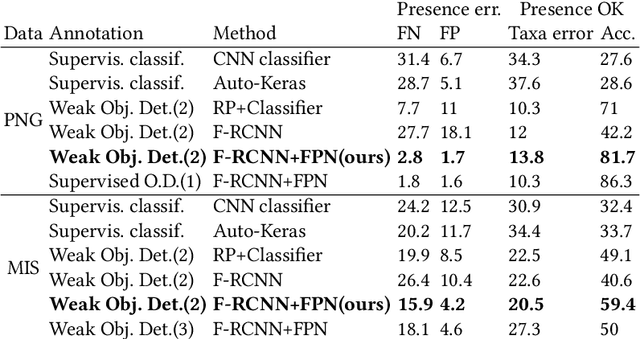
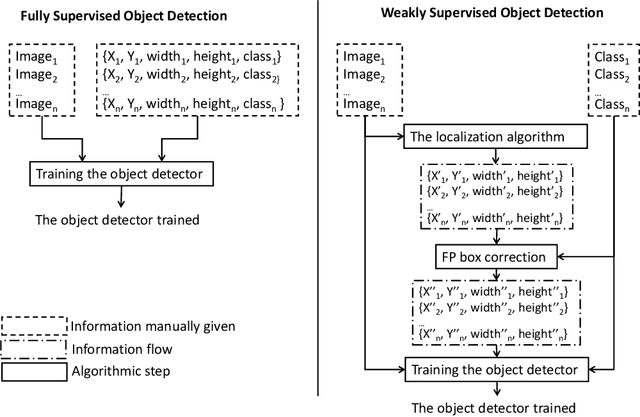
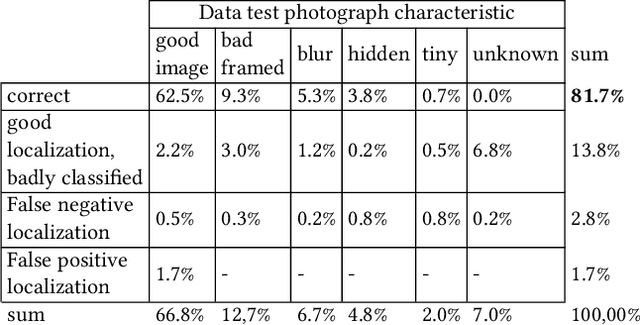
Abstract:Camera traps have revolutionized the animal research of many species that were previously nearly impossible to observe due to their habitat or behavior. They are cameras generally fixed to a tree that take a short sequence of images when triggered. Deep learning has the potential to overcome the workload to automate image classification according to taxon or empty images. However, a standard deep neural network classifier fails because animals often represent a small portion of the high-definition images. That is why we propose a workflow named Weakly Object Detection Faster-RCNN+FPN which suits this challenge. The model is weakly supervised because it requires only the animal taxon label per image but doesn't require any manual bounding box annotations. First, it automatically performs the weakly-supervised bounding box annotation using the motion from multiple frames. Then, it trains a Faster-RCNN+FPN model using this weak supervision. Experimental results have been obtained with two datasets from a Papua New Guinea and Missouri biodiversity monitoring campaign, then on an easily reproducible testbed.
An efficient and flexible inference system for serving heterogeneous ensembles of deep neural networks
Aug 30, 2022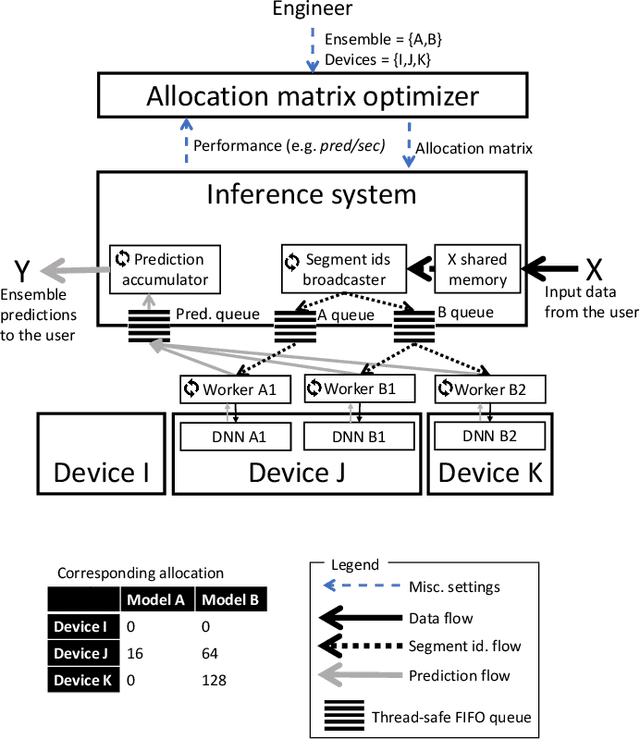
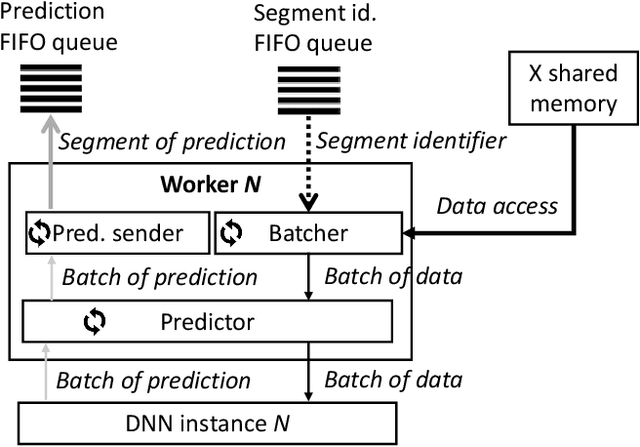
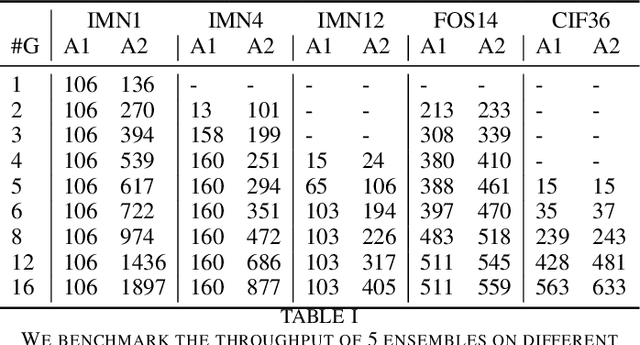
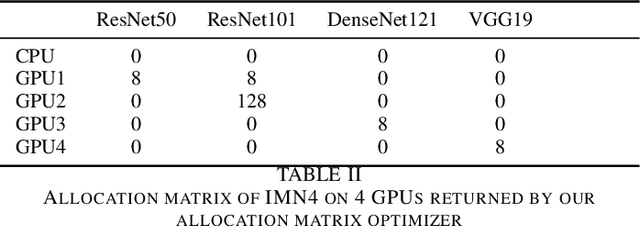
Abstract:Ensembles of Deep Neural Networks (DNNs) have achieved qualitative predictions but they are computing and memory intensive. Therefore, the demand is growing to make them answer a heavy workload of requests with available computational resources. Unlike recent initiatives on inference servers and inference frameworks, which focus on the prediction of single DNNs, we propose a new software layer to serve with flexibility and efficiency ensembles of DNNs. Our inference system is designed with several technical innovations. First, we propose a novel procedure to find a good allocation matrix between devices (CPUs or GPUs) and DNN instances. It runs successively a worst-fit to allocate DNNs into the memory devices and a greedy algorithm to optimize allocation settings and speed up the ensemble. Second, we design the inference system based on multiple processes to run asynchronously: batching, prediction, and the combination rule with an efficient internal communication scheme to avoid overhead. Experiments show the flexibility and efficiency under extreme scenarios: It successes to serve an ensemble of 12 heavy DNNs into 4 GPUs and at the opposite, one single DNN multi-threaded into 16 GPUs. It also outperforms the simple baseline consisting of optimizing the batch size of DNNs by a speedup up to 2.7X on the image classification task.
A Deep Neural Networks ensemble workflow from hyperparameter search to inference leveraging GPU clusters
Aug 30, 2022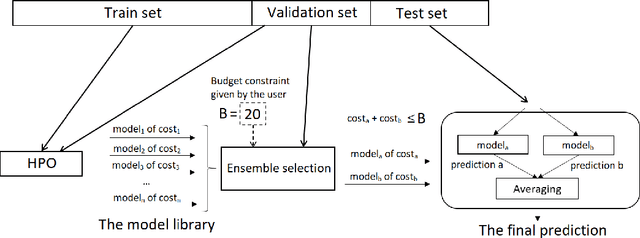



Abstract:Automated Machine Learning with ensembling (or AutoML with ensembling) seeks to automatically build ensembles of Deep Neural Networks (DNNs) to achieve qualitative predictions. Ensemble of DNNs are well known to avoid over-fitting but they are memory and time consuming approaches. Therefore, an ideal AutoML would produce in one single run time different ensembles regarding accuracy and inference speed. While previous works on AutoML focus to search for the best model to maximize its generalization ability, we rather propose a new AutoML to build a larger library of accurate and diverse individual models to then construct ensembles. First, our extensive benchmarks show asynchronous Hyperband is an efficient and robust way to build a large number of diverse models to combine them. Then, a new ensemble selection method based on a multi-objective greedy algorithm is proposed to generate accurate ensembles by controlling their computing cost. Finally, we propose a novel algorithm to optimize the inference of the DNNs ensemble in a GPU cluster based on allocation optimization. The produced AutoML with ensemble method shows robust results on two datasets using efficiently GPU clusters during both the training phase and the inference phase.
Ranking Viscous Finger Simulations to an Acquired Ground Truth with Topology-aware Matchings
Aug 20, 2019



Abstract:This application paper presents a novel framework based on topological data analysis for the automatic evaluation and ranking of viscous finger simulation runs in an ensemble with respect to a reference acquisition. Individual fingers in a given time-step are associated with critical point pairs in the distance field to the injection point, forming persistence diagrams. Different metrics, based on optimal transport, for comparing time-varying persistence diagrams in this specific applicative case are introduced. We evaluate the relevance of the rankings obtained with these metrics, both qualitatively thanks to a lightweight web visual interface, and quantitatively by studying the deviation from a reference ranking suggested by experts. Extensive experiments show the quantitative superiority of our approach compared to traditional alternatives. Our web interface allows experts to conveniently explore the produced rankings. We show a complete viscous fingering case study demonstrating the utility of our approach in the context of porous media fluid flow, where our framework can be used to automatically discard physically-irrelevant simulation runs from the ensemble and rank the most plausible ones. We document an in-situ implementation to lighten I/O and performance constraints arising in the context of parametric studies.
Lifted Wasserstein Matcher for Fast and Robust Topology Tracking
Aug 31, 2018



Abstract:This paper presents a robust and efficient method for tracking topological features in time-varying scalar data. Structures are tracked based on the optimal matching between persistence diagrams with respect to the Wasserstein metric. This fundamentally relies on solving the assignment problem, a special case of optimal transport, for all consecutive timesteps. Our approach relies on two main contributions. First, we revisit the seminal assignment algorithm by Kuhn and Munkres which we specifically adapt to the problem of matching persistence diagrams in an efficient way. Second, we propose an extension of the Wasserstein metric that significantly improves the geometrical stability of the matching of domain-embedded persistence pairs. We show that this geometrical lifting has the additional positive side-effect of improving the assignment matrix sparsity and therefore computing time. The global framework implements a coarse-grained parallelism by computing persistence diagrams and finding optimal matchings in parallel for every couple of consecutive timesteps. Critical trajectories are constructed by associating successively matched persistence pairs over time. Merging and splitting events are detected with a geometrical threshold in a post-processing stage. Extensive experiments on real-life datasets show that our matching approach is an order of magnitude faster than the seminal Munkres algorithm. Moreover, compared to a modern approximation method, our method provides competitive runtimes while yielding exact results. We demonstrate the utility of our global framework by extracting critical point trajectories from various simulated time-varying datasets and compare it to the existing methods based on associated overlaps of volumes. Robustness to noise and temporal resolution downsampling is empirically demonstrated.
Topologically Controlled Lossy Compression
Feb 08, 2018



Abstract:This paper presents a new algorithm for the lossy compression of scalar data defined on 2D or 3D regular grids, with topological control. Certain techniques allow users to control the pointwise error induced by the compression. However, in many scenarios it is desirable to control in a similar way the preservation of higher-level notions, such as topological features , in order to provide guarantees on the outcome of post-hoc data analyses. This paper presents the first compression technique for scalar data which supports a strictly controlled loss of topological features. It provides users with specific guarantees both on the preservation of the important features and on the size of the smaller features destroyed during compression. In particular, we present a simple compression strategy based on a topologically adaptive quantization of the range. Our algorithm provides strong guarantees on the bottleneck distance between persistence diagrams of the input and decompressed data, specifically those associated with extrema. A simple extension of our strategy additionally enables a control on the pointwise error. We also show how to combine our approach with state-of-the-art compressors, to further improve the geometrical reconstruction. Extensive experiments, for comparable compression rates, demonstrate the superiority of our algorithm in terms of the preservation of topological features. We show the utility of our approach by illustrating the compatibility between the output of post-hoc topological data analysis pipelines, executed on the input and decompressed data, for simulated or acquired data sets. We also provide a lightweight VTK-based C++ implementation of our approach for reproduction purposes.
 Add to Chrome
Add to Chrome Add to Firefox
Add to Firefox Add to Edge
Add to Edge